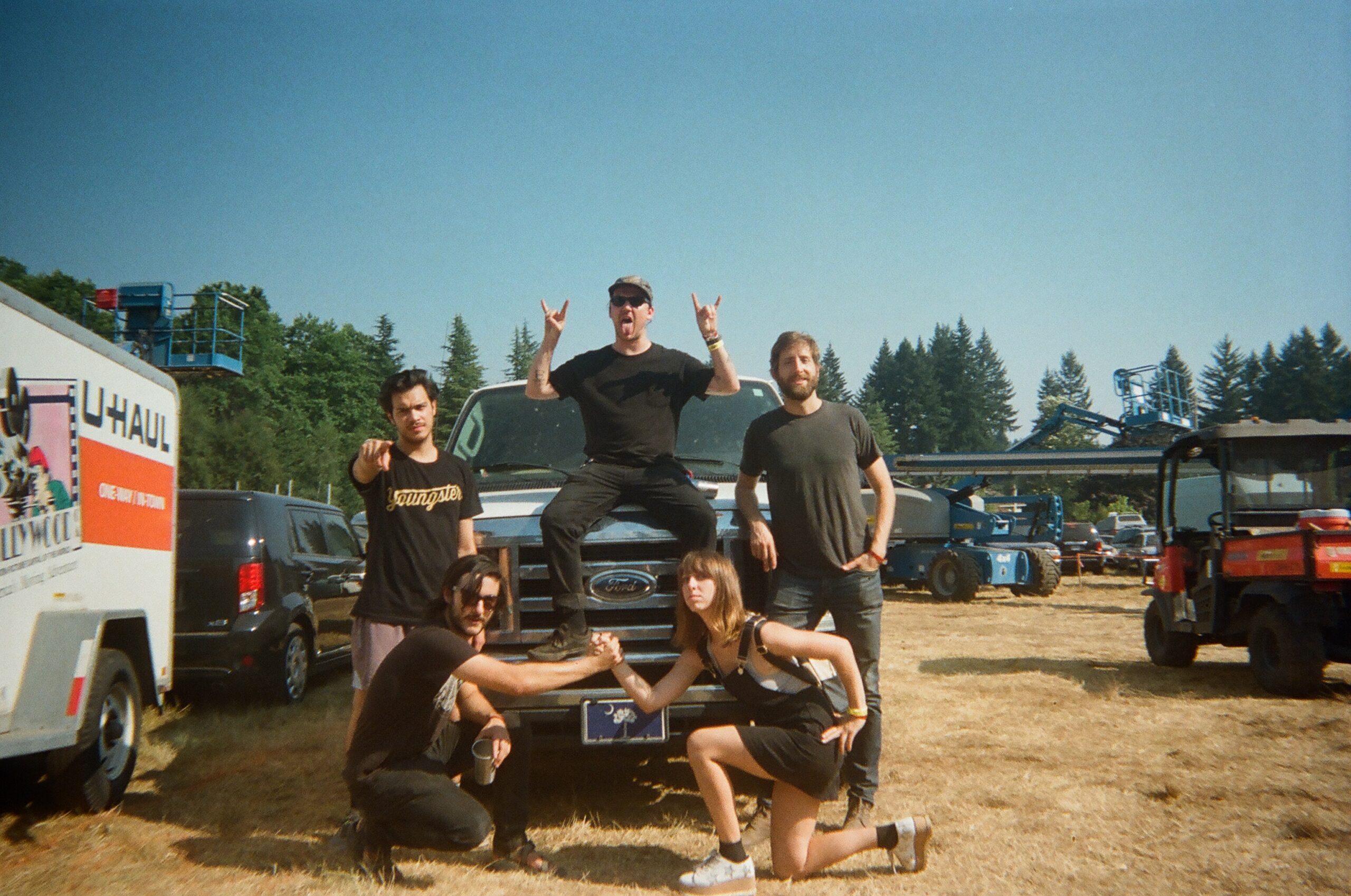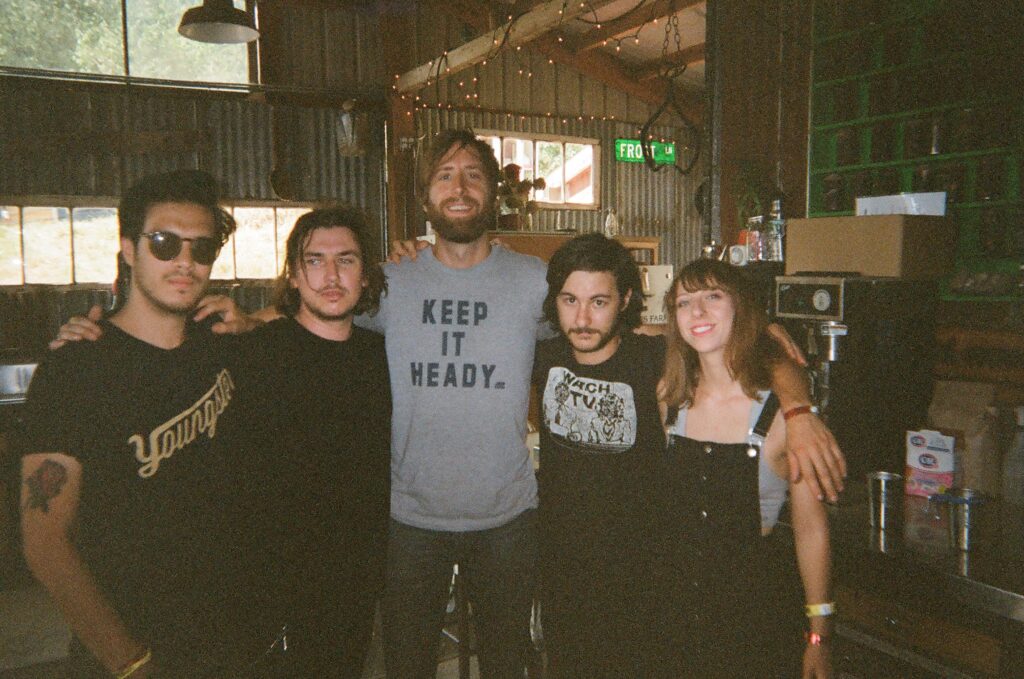We recently spent some time on a hay bale at Pickathon with Justin Osborne, founding member of Charleston, SC five-piece SUSTO. We chatted about things like coming to grips with how hard life is, realizing life can still be okay once your illusions about it have been shattered, giving up, un-giving up, whether or not there is a higher power, and of course the masterpiece that was the Pickathon lineup this year. Enjoy, and keep it heady, friends.
Vinyl Mag: So first of all—SUSTO translates to “panic attack”?
SUSTO: Well, it can be translated in a lot of different ways, but it’s like a folk-illness where you go through something traumatic. It can be a panic attack. It can last just like an hour, or it can be something you go through like a long state of depression, something like that. It’s kind of when you aren’t really yourself; you’re beside yourself and you’re overwhelmed…you feel like your soul is left, or anxious, or whatever.
VM: That meaning and the album & I’m Fine Today…it’s so relatable. That [one day at a time] living.
S: Well our first record was self-titled, because really the band name came from what I was calling the project, like the songs…I felt like the word “susto” really fit the first set of songs, and that kind of dealing with shit in your life feels very much present in all of our music, but it’s like, “okay, if the first record is called SUSTO, then the second record could maybe have a little more hope in the title and even in the songs.
VM: Even like you said, talking about things coming in waves, like “I’m fine today” holds a lot of meaning.
S: Well, I think it’s kind of the whole take-away from the record. Life is both, you know? It’s good and bad, and as you get older you have to learn that, and you learn to be prepared for that. To be prepared for highs and lows in life and just ride it out.
VM: It seems like in the record, it’s coming from a place of being at peace with that more.
S: Yeah, not being so thrown off by being blind-sided by life. I mean, the first record I was like, “oh shit, life isn’t what I thought it was going to be,” and the second record is kinda like, “okay, but it still isn’t that bad.”
VM: You—for a minute—thought you might be done with music before you started this?
S: Yeah, I tried to quit.
VM: How do you keep from getting burned out now?
S: You know, when I went to Cuba whenever I quit music, and I got to be around a completely different music environment—I’ve been working in the American music industry and spinning my wheels; I’ve even been touring since I was like 18…I was 25 or 26 whenever I decided I wasn’t getting anywhere, and so by then I inadvertently ended up getting around this music scene that wasn’t about getting big or anything like that—which don’t get me wrong, I still want to grow our band as much as we can—but I just fell in love with the music again and songwriting.
I learned how to do more open and less censored than what I was writing, too. I think I’ve kind of been reset ever since then. And because of that getting back into it, it’s been a lot easier this time through, because I’ve had the experience of last time, so I knew a lot of what not to do, and I’ve started to embrace too that this is what I do. I think for a while, when you’re in a band and you’re trying to tour but you haven’t really made it, you go home and everyone’s like, “still doing the music thing?” and you’re like “yeah…” and they’re like, “well, we haven’t seen you on late night or anything yet,” and it’s hard to reconcile with yourself. You always ride the fence. It’s hard to commit. At least, it was hard for me to commit. But I’ve committed fully this time, and it’s been really rewarding to just put myself into it, and I enjoy it a lot more now, and also we’ve had some reasonable success, so it’s been cool.
VM: So, in terms of what I’ve read and how you talk about your writing process, it seems like it kind of comes to you a lot…
S: I feel like it’s something I channel more than anything…it’s not like it just randomly hits me or something, but I can set the vibe to where it’s conducive for me. I like to write alone, and I like to do it in the morning time when I have the house to myself. I’ll get stoned, walk around the little parlor, guitar on my stomach, and just sing to myself. There’s no inhibitions when there’s nobody around, so I just kind of free-flow and, you know, a lot of it is garbage. But I do it a lot, whenever I get the chance. So some of it isn’t garbage, and there’s something either almost completely there, and sometimes it’s a piece of a thing that’s there, but even when there’s a piece of a thing, you’ll go into the studio with what I’ve got, and I like to just freestyle the lyrics and just sing it as I’m going.
I just don’t like thinking too much and forcing it. I used to try to do that whenever I was a kid, and I’ve just kind of turned away from that. I would sit in class and write lyrics. But I just like to let it come out of my body. I’ve been writing songs enough that if I just listen to myself, I’ll say what I wanna say.
VM: Do you have other creative outlets besides music writing?
S: Instagram. I have like four Instagram accounts. Really. They’re really stupid though. We have like all the SUSTO band stuff, then I have a personal one that’s just funny—I like to take pictures whenever…you know when you’re at a diner or a hotel, and they always have a picture of Marilyn Monroe and Elvis in it? I’ve got this running thing where I’ll get a picture with the picture of them and be like, “I can’t believe I ate at the same Applebee’s as Elvis and Madonna!” or whatever. I have another one where I just take stoner photos on the road, of like awkward stuff. I don’t put it out there, I just do it for myself, because I’m really bored in the van and take a bunch of photos. So no, I guess I don’t really have any other creative outlets [laughs].
You just premiered the video for “Jah Werx,” and first of all I wanted to talk about the concept for the video, but I also want to know what your take on the universe is because you’ve said you don’t believe in hell but also “Jah Werx” [is a reference to some sort of higher power].
S: Starting with the video, we worked with a director out of Nashville, called Matt DeLisi. He kind of had a vision for the video, of kind of like juxtaposing a child with a graveyard, because the song is kind of about dealing with death in a cyclical nature of things. It talks about lifetimes on Earth or in a carbon place which is Earth, and then you know, how it’s always back in the ground. So we wanted to juxtapose those two things, and also we kind of wanted to capture the environment—not the city environment, or the beach, but the kind of natural swamp environment around Charleston.
As far as how I see the universe? Personally, I try not to think about it too much anymore. I thought about it a lot for a long time, and I think this record and the last two records are gonna help me get a lot of that out of my system. I feel one way about it one day and then a different way about it another…I don’t really believe in God, or in like “Jah” is God. For me, “Jah Werx” means “it’s all good,” you know? I mean, I am a big stoner, and I smoke a lot of herb, and I’m kind of in to Rasta culture, a really big fan of Bob Marley—he’s probably one of my favorite artists…we have the song “Jah Werx” where it’s a triumphant mantra, you know? Like “Jah Werx! I’m fine today.” I don’t know how to explain it; there’s no concrete. We get caught up trying to have firm ideas about the universe and about life, and I think it’s kind of more important to understand that everything is fluid. When things are good, say “Jah Werx.” But when things are bad, say “Jah Werx,” too.
VM: So you opened for The Lumineers, and now you’re doing the headlining thing. How do these experiences compare? What did you learn?
S: Absolutely different. They’re both really fun. Getting to open for The Lumineers was really cool because we were playing in arenas and getting to do that—as someone who’s been trying to play music as much as I can since I was 15, it was an incredible experience. I just like getting to jam and soundcheck and then getting into the arena; there’s no sound like an arena sound. But at the same time, you’re playing first out of three, because Kaleo was on that tour, too, and Kaleo is pretty fucking big—and they’re awesome, too. We were surprised: it was usually pretty full—it wasn’t packed—but also the same time it was people who had mostly never heard of us before, so we were winning people over, and we have a shorter set. Picking which kind of set you think is going to work for their audience, at the same time not compromising who you are…but we also learned to be more showman. Our rooms are big; we have to make bigger gestures and really try to entertain. Watching bigger bands, you learn, “oh, this is how you entertain.
VM: So who are you most excited to see this weekend? You’re not here very long.
S: I have to leave like, right now. But I’ll tell you who I’m really bummed I’m not gonna see: Julia Jacklin. I want to see Julia Jacklin so fucking bad, and I haven’t yet. I want to see Aldous Harding…and Andy Shauf. I’ve been trying to see all of them for probably over a year now.
Check out SUSTO’s disposable camera tour diary below.
Also be sure to catch the band on their current co-headling US tour with Esmé Patterson. Seriously go.
[/tps_header]Keep It Heady


